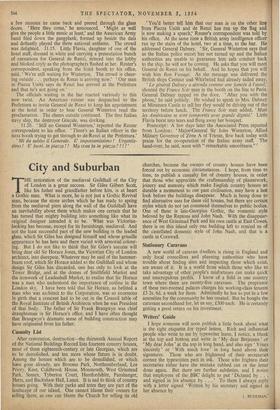City and Suburban
THE restoration of the medimval Guildhall of the City of London is a great success. Sir Giles Gilbert Scott, like his father and grandfather before him, is at heart a Gothic man. What is more, he is not just a Gothic Revival man, because the stone arches which he has made to spring from the medieval piers along the wall of the Guildhall have an inevitability about them which makes one certain that he has turned that mighty building into something like what its original designer intended it to be. What was Victorian- looking has become, except for its furnishings, mediwval. And not the least successful part of the new building is the leaded glass, which Sir Giles has designed himself and whose grisaille appearance he has here and there varied with armorial colour- ing. But I do not like to think that Sir Giles's success will bring dear old Sir Horace Jones, the Victorian City of London architect, into disrepute. Whatever may be said of the hammer- beam roof, which Sir Horace added to the Guildhall and whose design Sir Giles has discarded, one has only to look at the Tower Bridge, and at the domes of Smithfield Market and the ironwork of Leadenhall Market, to realise that Sir Horace was a man who understood the importance of outline in the London sky, I have been told that Sir Horace, as befitted a man who was architect to the Corporation, was so enormous In girth that a crescent had to be cut in the Council table of the Royal Institute of British Architects when he was President of that body. The father of Sir Frank Brangwyn was chief draughtsman in Sir Horace's office, and I have often thought that Brangwyn's dramatic sense of building construction may have originated from his father.
Casually List After restoration, destruction—the thirteenth Annual Report of the National Buildings Record lists fourteen country houses, most of them eighteenth-century or late Georgian, which are to be demolished, and ten more whose future is in doubt. Among the houses which are to be demolished, or which have gone already, are Broome Park, Northumberland, Lee Priory, Kent, Coldbrook House, Monmouth, West Grinstead Park, Sussex, Tyberton Court, Herefordshire, Panshanger, Herts, and Buckshaw Hall, Lancs. It is sad to think of country houses going. With their parks and trees they are part of the landscape of our island. One cannot blame their owners for selling them, as one can blame the Church for selling its old churches, because the owners of country houses have been forced out by economic circumstances. I hope, from time to time, to publish a casualty list of Country houses, in order that those who appreciate the craftsmanship of plasterwork, joinery and masonry which make English country houses so durable a monument to our past civilisation, may have a last look before the buildings disappear. Much is being done to find alternative uses for these old houses, but there are certain styles which do not yet commend themselves to public bodies. One of these is late-Georgian Gothic, the romantic style beloved by the Reptons and John Nash. With the disappear- ance of West Grinstead Park and his own castle at East Cowes, there is on this island only one building left to remind us of the castellated domestic style of John Nash, and that is a castle in Cornwall.
Stationary Caravans A new world of caravan dwellers is rising in England and only local councillors and planning authorities who have trouble about finding sites and inspecting those which exist, are aware of it. It is a world from which those who like to take advantage of other people's misfortunes can make quick and unscrupulous profits. I know of a field in one country town where there are twenty-five caravans. The proprietor of these two-roomed palaces charges his working-class tenants £3 2s. 6d. a week for them. Admittedly he has to put in a few amenities for the community he has created. But he bought the caravans secondhand for, let us say, £300 each. He is certainly getting a good return on his investment.
Writers' Guide I hope someone will soon publish a little book about what is the right etiquette for typed letters. Rich and influential people who write to me by typewriter leave, I notice, a blank at the top and bottom and write in My dear Betjeman ' or 'My dear John' at the top in long hand, and also sign Yours sincerely' or With much love' in long hand above their signatures. Those who are frightened of their secretaries correct the typewritten part in ink. Those who frighten their secretaries either have the mistake rubbed out or the letter done again. But there are further subtleties, and I notice that employees of the BBC delight to put Dictated by . . . and signed in his absence by . . . ' To them I always reply with a letter signed 'Written by his secretary and signed in her absence by


































































 Previous page
Previous page